|
|
|
 |
We are Here: Love Never
Dies
A new book by
Jane Smith Bernhardt
Click for Details
Available locally at:
|
|
Spiritual Sustenance
for
Occupy
Together

|
Visit
Spiritual
Sustenance
on Twitter
|

|
Click
to hear Jane's Interview with
Lea
Hill on the Spirit Connection |
|

Saturday June 11, 10-7pm
Outside, On Breathtaking Marblehead Neck |
Jane
offered a presentation
and book signing,
of her book
We Are Here.
Copies of a
first draft
of Jane's latest offering,
The Sweet Conversation
were available.
|
|
Click
to hear Jane's Interview with
Lea
Hill on the Spirit Connection |
 |
 |
Jane's podcast with Camille Adair
was picked as a favorite on the
AgeNation website.
Click
to listen. |
|
Jane is featured in
a promo clip for the
Ambercare Hospice program
A
Year of Solace
produced by Camille Adair
watch it on the
Youtube
station
Solacewisdom
|
|
Amesbury News article
featuring
Jane's Hibakusha Peace Project Show at the
Amesbury Friends Meeting House |
 |
|
Click to open the PDF file of
Jane's
article in the February 2011
edition of
Personal Excellence |
 |
|
Read Jane's Interview
with Pat Lynch,
Host of Speak Up!
on
WomansRadio |
 |
|
These
photos are from an exhibit of giclee reproductions
of the portraits
and stories of the
Hibakusha Peace Project Exhibit in
Hiroshima's International House on August 7, 2010.
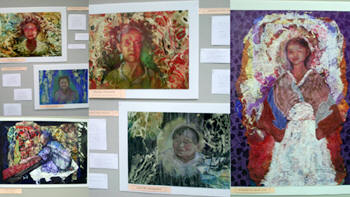
The event was a memorial program to commemorate
the 65th anniversary of the atomic bombing of Hiroshima
City,
which also featured the premiere of
David Rothauser's film:
Hibakusha, Our Life to Live.
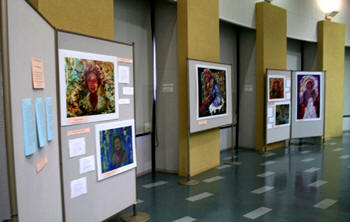
Now a permanent copy of the exhibit resides at the
World Friendship Center in Hiroshima, along with
translated messages
from Americans who have viewed the portraits and stories
and responded with their heartfelt wishes and prayers.
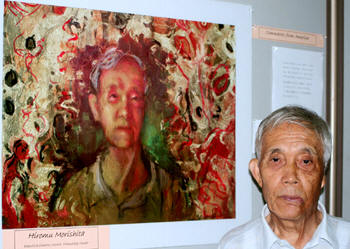
Photo of Hiromu Morishita standing
beside his portrait. |
|
Jane addressed a
Conference in
Santa Fe, New Mexico
Saturday
October 16, 2010
The Gift of Hospice: Opportunities at the End of
Life
Presented by Ambercare Hospice
|

www.ambercare.com |
|
Listen to Jane's interview on
Strategies for Living
September 14, 2010
|
 |
|
Jane's Interview with Camille Adair
Host of
Life Long Practice...Living and Dying
Listen to the Podcast |
|
Jane Bernhardt is featured in
John Walters' new book,
Roads Less Traveled:
Visionary New England Lives.
|
 |
|
Jane is
featured in a new book:
He Blew Her a Kiss: Inspirational Stories of
Communication From Loved Ones Who Have Passed,
by Angie Pechak Printup and Kelley Stewart Dollar
Website link |
 |
|
Listen to Jane Bernhardt's interview
with Jeff Ferrannini
Host of Planetary
Spirit
From
August 5, 2010 |

Audio
courtesy of ETIN |
|
August 8, 2010
Read Jane's Columns on the
Spiritual Media Blog
abcnews.go.com/GMA/Spirituality
Interview with Jane Bernhardt
The Great Awakening
Beyond Hereafter |
 |
|

Read Jane's Article Try on Hope
July Issue of Leadership Excellence
Download PDF - Article is on Page 16 |
|
Listen
to a great interview with
Jane Bernhardt
July 15,
2010 |
 |
|
Read Jane's Article
Life after death: Love never dies
The Washington Post
|
 |
|
Read Jane's Column on
www.abcnews.com/spirituality
Type "Jane Bernhardt "
in search bar.
|
 |
|

Speaker in Psychology of
Creativity PSY 245
April 9, 2010 - Friday
10:30-11:50 AM
Wadleigh Library Conference Room
|
Jane Bernhardt
All are welcome to hear Jane speak on the
creative process.
Her latest book is
We Are Here:
Love Never Dies.
She has traveled extensively with her visual art
exhibits and original solo dramatic performances.
Finding in art a pathway to the heart and spirit,
Bernhardt uses creativity as a vehicle for human
transformation.
From Auschwitz to
Hiroshima, from Russia to our inner cities, teacher,
author, portraitist, and actor, Bernhardt’s art has
taken her all over the world.
A third generation
portrait artist and seasoned actor of stage and
television, graduating from the American Academy of
Dramatic Arts in Manhattan, she poignantly combines her
portrait skills and acting in projects such as the
Hibakusha Peace Project.
|
|
 |
2006 Remarkable Women
of New Hampshire Magazine |
|
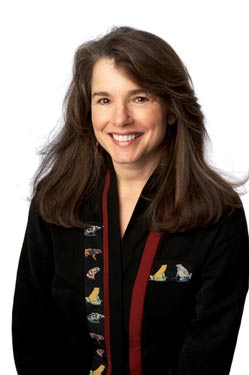
Photo by John Hession |
Actor on the Barricades
Jane Bernhardt: A multi-faceted talent who expresses her
political and spiritual beliefs in her work. She
combines her skills in acting and portraiture by
creating exhibit/performances on subjects like Japanese
A-bomb survivors, clients of an inner-city food program
and people who have risked their lives
resisting injustice.
Bernhardt's first career was in acting; her All-American
good looks led to steady work in national TV ads for
toothpaste, shampoo, diapers, fast food and many other
products. “I made more money then than I have ever
made,” she says, “but I didn't attend
drama school to sell products.”
After many years as a portraitist, she began developing
the combined works she is known for today. Her next work
will be about
the Middle East. Ultimately, she hopes to span the globe
with pieces that reflect a new paradigm of peace and
justice.
|
|
Listen to
an hour long interview
with Jane
www.planetary-spirit.com
Listen to
Author Jane Bernhardt's
Interview September 20, 2009
on Planetary Spirit with Producer/Host Jeff Ferrannini
|
|
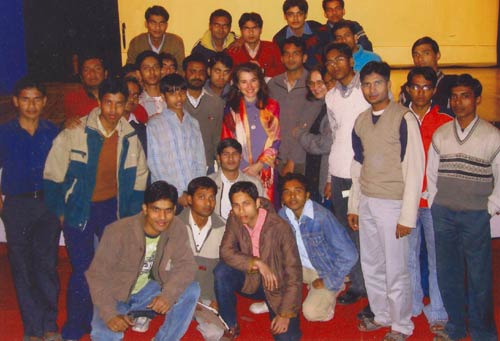
Jane (center)
Lecture / Presentation ~ Dec 1, 2006
Muslim University
Ahigarh India
|
|
Artist
promotes peace in portraits
by
Pamela Mcloughlin , New Haven Register Staff, August 25,
2004
MILFORD- The portrait artist's images of Hiroshima
survivors
are meant to engender peace.
The
artist, Jane Smith Bernhardt, recently shared those
images with an eerily similar group: Families of 9/11
victims who also see peace, not war, as the way to fight
terrorism.
Bernhardt, also an actress, visited the Promoting
Enduring Peace headquarters on Beach Street, where her
latest venture, The Hibakusha Project, had been on
display in early August. Bernhardt, who lives in
Massachusetts, created the series of collage portraits
after traveling to Japan and listening to the stories of
atomic bomb survivors, known as The Hibakusha. Her
thinking was that if people could put a face to the
suffering, they'd find it harder to tolerate
proliferation of nuclear weapons. She hopes the images
will serve as a deterrent, the way sharing details of
the Holocaust is intended to deter.
"The stories are heartbreaking, but these are the
fruits of nuclear weapons," Bernhardt said.
Many of the survivors in her portraits were very young
on Aug. 6, 1945. Many saw relatives die or become maimed
before their eyes. Many people, on fire, jumped into the
river to douse the flames and drowned. Others lingered,
ill from radiation.
"Everyone talks about how they walked and walked
and kept walking over dead and wounded bodies, and one
woman said that even now, when she walks barefoot, she
can feel the bodies," Bernhardt said. "The
extraordinary thing about Hiroshima is they don't talk
about revenge. They say 'no more.' "
That desire for peace - and disdain for revenge - is
also what binds the group of September 11th Families for
Peaceful Tomorrows, who, as part of an event called the
Stonewalk, are walking from Boston to New York City and
recently stopped in Milford. Walk organizer Dan Jones
said Tuesday via cell phone that the walkers were in
Darien and hoped to reach the New York City border
sometime today.
Everyone in the group lost someone in the terrorist
attacks - either on an airplane or in the Twin Towers.
For Jones, it was a brother-in-law.
"Our families died publicly, and we received a lot
of comfort and support," Jones said. But in other
parts of the world, where civilian casualties constitute
80 percent of deaths in war, there's little comfort
and support for those families.
The group's symbol for the walk is a 1,400-pound
memorial stone to unknown civilians killed in war. Jones
said the group hoped during the journey to bear witness
to the "tragic reality" of civilian
casualties, and without becoming political, hope the
toll be a prime consideration in United States' policy-making decisions.
Bernhardt noted that when The Hibakushas visited Ground
Zero, they wanted to be escorted there by members of
Peaceful Tomorrows. "There's a natural
connection," she said. The Japanese survivors
wanted the 9/11 families there to help send the message
of peace, not retaliation or escalating hatred, she
said.
Bernhardt wound up speaking very little about her own
exhibit during the evening she spent with the walkers at
Promoting Enduring Peace after they had walked 14 miles
that day in the hot sun. She opened the floor to them
and what followed was a river of testimony about how
members of the group had become important to one
another, especially in healing.
Loretta Filipov of Massachusetts, whose husband,
Alexander, was killed on Flight 11, says of her fellow
walkers, "It's my new best friends that I never
wanted to have."
|
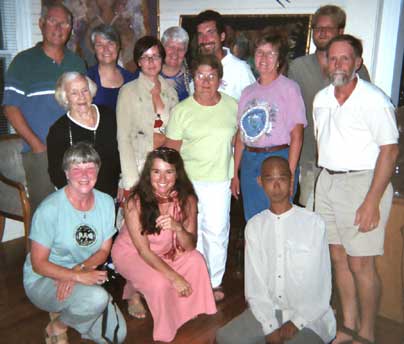
Jane with a group of September 11th Families for
Peaceful Tomorrows
|
|
|

News article written by reporter J.C. Lockwood
Merrimack River Current, February 20, 2004
Beverly artist draws on the horrors of Hiroshima for
a fiery,
chaotic take on survivors' stories
|
|
Jane Bernhardt
is no stranger to politics and politically charged art.
The Beverly resident is an actress and a painter - and a
peacenik and social justice activist who's been in the
trenches for years, in the protest lines, in the soup
kitchens and in-your-face. She began to combine art and
activism more than two decades ago, believing that
social transformation "begins with a conversion of
the heart," something better achieved with human
contact and expression than reason and cold fact.
Bernhardt's "conversations" over the years
have led to three major exhibits since the 1980s, each
one exploring political or social issues, but trying to
get beyond the familiar polemics, to the people: One
looked beyond the Cold War to the people of Russia;
another at the "faces of resistance,"
examining issues of civil disobedience; the third was a
series of portraits of the "dinner guests" at
a Malden soup kitchen, people who have been
marginalized.
Her latest exhibit, which opens next week at Beverly
Public Library, is called The Hibakusha Project. It is a
series of collage portraits of atomic bomb survivors,
accompanied by their stories and poems. It is also, she
says, an opportunity to reflect on the memory of
Hiroshima with the hope of transformation. Bernhardt,
who is also an actress and graduate of the American
Academy of Dramatic Arts in New York, was in Hiroshima
for two weeks in August, during the annual ceremonies
commemorating the bombing that brought World War II to
an end, killing more than 300,000 people - 70,000 of
them instantly. "It was emotionally
difficult," she says, at first making a comparison
to the concentration camps at Auschwitz, where she
performed "Love, Etty, "the story of a Dutch
victim of the Holocaust. "No," she says,
"it's not worse than Auschwitz, but it's similar in
its unbearable qualities, in that range of darkness
that's so intense that you're afraid that you will not
be able to find your life again after you come home. It
changes you.
Bernhardt was born in New Canaan, Conn., an affluent
bedroom suburb of New York. In 1971 she graduated from
the Academy of Dramatic Arts in Manhattan. She found
plenty of gigs - like one-day roles on "One Life to
Live" and other soap operas, and piles of work
pitching products like Ultra Brite, WetOnes, Dentyne
-but not the kind of work she wanted. "I made more
money then than I ever have since," she says,
"but I didn't attend drama school to sell product.
I wanted to be a real actress. I was happy I could do it
and make some money doing it, but it's not what I signed
up for." Bernhardt decided to leave the acting life
behind, for a while at least, and moved to the North
Shore - first Manchester, then Beverly, where she has
lived for the past 10 years. She got married and settled
in for the maternal long haul. With a family, theatrical
work was pretty much out the window. "I never felt
in the position that I could be faithful to the
rehearsal schedule," she says. For creative work,
Bernhardt turned to painting. She hadn't done much in
the way of visual arts, but both her mother and maternal
grandmother were portrait artists, and before moving to
the North Shore she had begun taking painting classes at
Silvermine College of Art. "And loving it,"
she says. "I began making the shift
inward."
Bernhardt first started thinking about a project
involving the Hibakusha, as survivors of the atomic bomb
are called in Japan, after reading about a United States
plan to develop and deploy a new generation of tactical
nuclear weapons that would be three times the size of
the weapons dropped on Japan. "That resonated in me
in a deep and disturbing way," she says. And she
had heard the Hibakusha speak in the past. "That's
something you never recover from," she says.
"It's the most heartbreaking, unfathomable,
grotesque reality. Each one bears scars on the flesh and
speaks of the unspeakable. "She knew she wanted to
do something, and she knew she could not approach the
project in an abstract way: Her work requires a personal
connection. "I need to absorb the spirit of the
person before I can paint them," she says. "I
have to let them inhabit me." She also knew that
time was running out. The Bomb dropped nearly 58 years
ago. Soon the time will come when there are no Hibakusha
left to tell their stories. In the spring she put out
feelers to peace groups like the American Friends
Service Committee, and within weeks she had gotten
hooked up with names and addresses and a translator.
Soon she was at the original Ground Zero. "It came
together so easily," she says. "This confirmed
to me that this was a calling." Every picture tells
a story.
The work - some of which was done in Japan, some
recreated from photographs after the artist returned
home - is not traditional portraiture by any means. It
is collage, using layers of handmade papers and paint
and creating a fiery, chaotic background from which the
portrait, done in pastel, emerges. There are 15 pieces
in all. "She's very good at capturing something of
the spark of a person, at finding the spirit and soul of
the person," says Nancy Philo Oleson, owner of
HyperbOle Gallery in Newburyport, which will host The
Hibakusha Project after it closes in Beverly. "That
is what makes her such a good portrait artist." But
the art is only part of the exhibit, which will include
a number of journal entries and text, and poetry from
survivors. The reception, which takes place from 7to 9
p.m. Feb. 3 in Beverly, will be a ceremonial opening,
and will include live performances - including an
original musical score by Geta Bro - and readings by
Bro, Bernhardt and actor-musician Paul Brotchie. There
will also be an invitation for meditation and messages,
which will be returned to the survivors and released
into one of the rivers of Hiroshima.
|
|
Jane
teaches and lectures on a variety of topics including
spiritual guidance,
portraiture, resistance and social transformation.
Contact
Jane for details.
|
|
|
|
|
|
|